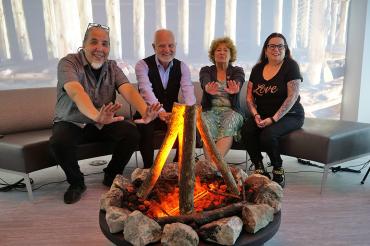Digitally immersive, land-centred space at OISE to support Indigenous research

Published: August 5, 2022
A new digitally immersive, land-centred learning environment at the Ontario Institute for Studies in Education will provide a key space for Indigenous-specific research – a place where Indigenous faculty and students can access Indigenous resources, collaborate on research projects, and engage in critical conversations about their work in a sacred space.
Part of OISE’s Indigenous Educational Research Centre, the land-centred learning environment was recently revealed by Associate Professor Sandra Styres, her research team and Elder Clayton Shirt alongside the Deepening Knowledge Project (DKP) and Indigenous Educational Research lab.
“I feel honoured to be here on the very first day of the launch of DKP,” said Normand Labrie, OISE’s interim dean, said in late June. “It is a great addition to OISE and an incredible space for our researchers and educators to collaborate, lead and connect on Indigenous research and excellence,
The Deepening Knowledge Project: Indigenous Knowledge Resurgence and Education seeks to infuse Indigenous Peoples’ histories, knowledges and pedagogies into all levels of education in Canada. It was created by OISE’s Indigenous Educational Research Centre and is connected to OISE’s department of curriculum, teaching and learning (CTL).
The digitally immersive, land-centred floor space, meanwhile, combines Indigenous traditional knowledge with a 360-degree immersive learning experience.
“With the national spotlight still on the reconciliation project and with education seen as a critical site for reconciliatory efforts, there's a significant attention to the importance of addressing Indigenous rights in national and global conversations about Indigenous education,” said Styres, a Canada Research Chair in Iethi’nihstnha Ohwentsia’kkha (Land), Resurgence, Reconciliation, and the Politics of Education.
“Some examples of these are found in the ways we occupy the space to make it placeful, the ways we enter the space, the furniture placement open to the East and West directions, the use of sacred fire with tobacco and 360 imaging in the room around you.”
Led by a group of Indigenous and non-Indigenous faculty, students and staff, DKP is a hub that provides access to resources about the history and perspectives of First Nations, Métis and Inuit Peoples along with other Indigenous cultures. It also provides curricula for teachers to incorporate into their teaching practices and content areas related to issues of pressing concern to Indigenous Peoples and their communities.
“I realized today, listening to the ceremony and sitting in the room with community, that going through the pandemic has somehow raised the importance and the reality of the potential that this project has,” said Associate Professor Clare Brett, chair of the department of curriculum, teaching and learning. “I see it now as being a real fulfilment of some of the promise of what we saw during COVID-19 – this movement towards a more hybrid world. And now we have this centre, which is a wonderful embodiment of that.”
The digitally immersive, land-centred space, DKP website and Centre for Indigenous Educational Research computer lab provide a forum for Indigenous students, faculty and staff to share their own stories, build connections with one another and activate understandings on what it means to be in good relationships with Land that has and continues to exist first and foremost in relationship to Indigenous Peoples.
Ryan Neepin, the project co-ordinator of the Deepening Knowledge Project who oversaw the development of the website, invites all teachers across Canada to infuse and integrate Indigenous knowledge, content and perspectives into their classrooms. DKP also features Indigenous authored content and resources for all school grades and materials for educators that have been vetted by Indigenous faculty and staff on the team.
“It is the knowledge we want you to know, and we are asking you to walk into a relationship to learn,” said Neepin. “So, we talk about the Truth and Reconciliation Commission before we move into reconciliation. Reconciliation – or as Dr. Styres called it, reconcili-action – requires that we do the hard work of truthtelling first, and that’s what this website allows us to do together.”
With access to research and language software, the centre’s computer lab will provide resources for students to use fonts and keyboard layouts that will allow them to type in several Indigenous languages.
“It is a doorway,” said Brett. “And you can think about how we can use this best as we move forward to really empower the next generation of Indigenous students.”


